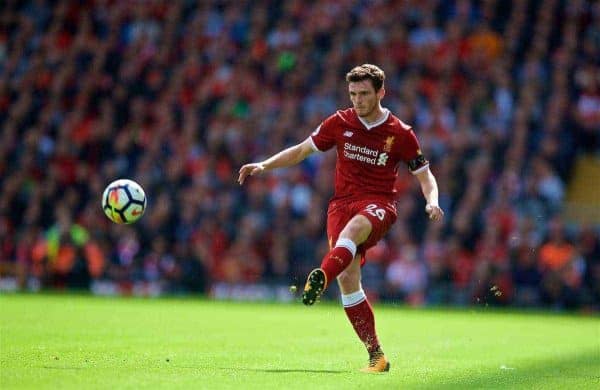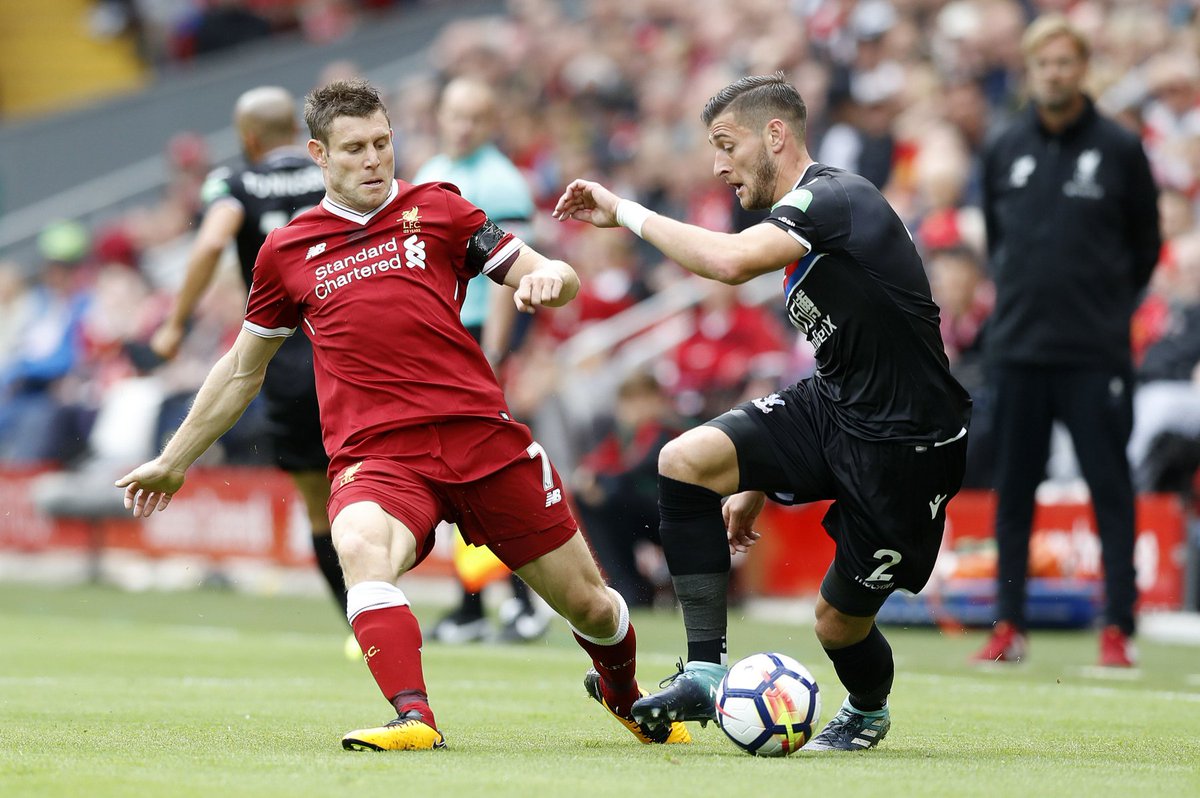Roundtable: Liverpool vs. Palace 19 August 2017
Posted by BabuYagu on August 20, 2017, 12:06:38 am
Second game of the season and we face a relegation tipped side who are both compact and with either high defensive pressing (starting around 35 yards from goal) or deep defensive pressing (starting around 20 yards from goal). They happily gave up the left flank and our left back had far more touches than any other player on the pitch. Our left back's lack of explosiveness, coupled with his left footed crosses tending to lack power &/or be floated into the box favouring the defence meant the opposition were happy to stand off him and concede the entire left flank to him given his first touch was usually to cut inside back into the compact block and offered little to no threat around, behind or through it.
Expected Goals for our 0-2 defeat at this time last season
But enough of the 0-2 defeat to Burnley, this was an entirely different game, albeit with some clear similarities in terms of the type of opponent faced, when we faced them, and the fact our left back was our most common outlet for a pass.
I stated when Robertson was signed that this would be an important signing for us against low block teams. A left footed left back will allow us to better stretch teams horizontally which naturally creates more spaces in the central areas for our more creative players to thrive. Today, arguably, we didn't even have those creative players and yet we still did enough to crawl over the line with 3 points. It really doesn't matter at the moment how we got those points, just that we did. You take 4/6 points at this point in the season against two sides who historically come up as boggie sides. Add to that a 2-1 away in the UCL qualifier against a side unbeaten at home for 16 months and suddenly the first 3 results look decent even if performances have not looked impressive - yet.

Heat Map for Milner v Burnley (left) and Robertson v Palace (right)
A lot has been made of Robertson's crossing but those two boxes I have highlighted above should be even more encouraging to you. Milner's heat map shows who he came inside a lot in front of the block, or down the side of the block, but never really attacked the block itself and made any runs that would destabilise it, commit defenders draw central players out towards him and offer a real goal threat.
In comparison, that red square is Robertson getting in behind, or around the Palace right back several times during the game. The orange square is Robertson taking advantage of the space between the right back and right center back to attack the box itself. Everytime something happens in those areas, it will draw central players out of position and create space for our central players to get into goal scoring positions easier or shots under less pressure from balls into the box.
Getting back to his crosses - I'd like to point out again the value of putting the ball into dangerous areas hard an low. People are rightly praising Robertson's crossing but, in truth, he completed 0/8 crosses (according to opta). The 14th minute cross to Matip is actually deemed an unclaimed cross by opta - as in, keeper got fingers to it but didn´t claim the cross of clear it with his touch. When you compare the crossing of Milner (1/9 completed) & Robertson from the two games, the difference is in the threat the crosses posed to the defence. Robertson's were often played in early, from deeper areas, moving away from the keeper with defenders running towards their own goal. Milner's were from deeper, usually after coming inside on his right, curling towards the keeper with defenders set and able to attack the ball. The one cross Milner completed was him driving towards the byline, crossing left footed, floated to the back post.

Chances created for Milner v Burnley (left) and Robertson v Palace (right)
Despite Robertson technically not completing any crosses, 4 goalscoring opportunities happened as a direct result of his balls into the box and also was involved in the buildup to the goal with a little lay-off to Mane.
A look at the above "key passes" map shows you the difference in threat posed from the two left backs. One of Milners was a short corner which he passed to Lallana who carried it into the box and had a shot (xg value 0.05). The other three was bringing the ball inside onto his right foot and setting up Coutinho for a long range effort(xg values of 0.01, 0.03 and 0.04). Whereas Robertson's included a first time left footed cross off a short corner to the back post where Mane challenged a Palace defender for the ball which the keeper easily saved. The aforementioned chance Matip missed. These were the two biggest expected goal chances of the game with values of 0.5 and 0.67 respectively. His other chance created was a throughball in behind the fullback which Milner ran onto before hitting his shot right at the keeper from an angle (xg value 0.05).
In total - the creative output of Milner vs Burnley was valued at 0.18 expected assists(xA). This means that based on the quality of chances he created, you could reasonably expect to score 0.18 goals. Whereas Robertson's chances created were valued at 1.21 expected assists. The two shots he had himself also had an expected goal(xG) value of 0.07. To put Robertson's score in context - at Hull in 2014/15 his expected goals out for the entire season was xG 0.34 and xA 1.07. Last season on his return to the Premiership, his output for the entire season was xG 0.25 and xA 1.39. Once again just highlighting how hard it is to judge the attacking output of players at lower league sides.

Robertson demonstrates his best shotgun spin from his figure skating days before binning the skates to become a footballer
Criticism? I noticed his recovery runs are more of a jog than a run. A good example would be Puncheon's chance on the 41st minute. He is ahead of the ball for the whole passage of play on the left wing and never really breaks into a sprint to get back. It's actually a common problem with players who run harder forward than they do to get back. One of the reasons I wanted Keita as he seems to be the opposite (reminders of Mascherano). Against better sides, that will be a problem.

Also you have to give a lot of credit to Milner in the game. If you watch the chance Benteke had in the 55th minute, Robertson puts pressure on the ball and pushes play back into the Palace half. Robertson is now out of position and high up the pitch and any ball in behind him will expose his position. What we have seen recently with our midfield (e.g. Can against Hoffenheim when we conceded the penalty) the wide midfielder doesn't fill in for the full back when he presses high up the pitch. Milner did this excellently and, although Palace still created something from this passage of play, this was more due to Klavan's inability to deal with 1-v-1 situations than the midfield not filling in and covering behind the full back. Milner had tucked in but just wasn't able to help as Klavan failed to slow down Loftus-Cheek long enough for Milner to get round behind him and cover / double up.
Milner to Robertson (33 passes) and Robertson to Milner (31 passes) were the two biggest passing combinations in the game which just highlights how well the two players linked up throughout the game both defensively and offensively.

Other thoughts? We really need another player who can receive the ball at pace in tight spaces, turn on the ball, play through tight spaces if we are going to succeed against low block sides more often than not this season. At the moment we have Lallana, Coutinho and maybe Woodburn - all of whom we cannot rely on in the immediate future.

This shows the expected goals values of the chances created (left),
and the timeline of the game in terms of scoring chances (right).

Thoughts RAWK?
LFC forum latest
-
Previous incidents and near misses at Hillsborough by The Tenacious Kennedy
-
Ronnie King (The 98th Angel) by mikeb58
-
'The Pain of Injustice': Excellent Article from David Conn by No666
-
Justice Delayed is Justice Denied by PhilScraton
-
Hillsborough article in The Athletic. by Alan_X
-
David Conn Long Read by Circa1892
-
RIP Andrew Devine by TepidT2O
-
Rest In Peace David Church, father of Gary Church - funeral Tue Nov 14th by 24/7
-
MOVED: CPS Announce Hillsborough Charging Decisions by SP
-
Hillsborough: how one academic kept the ‘truth’ from being hidden. by nokando